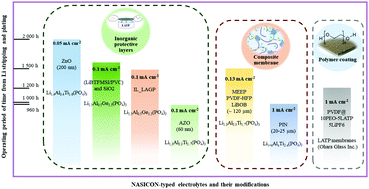Interface modification of NASICON-type Li-ion conducting ceramic electrolytes: a critical evaluation
Abstract
This review article focuses on the methods to solve the critical issue of reduction in NASICON-type solid electrolytes such as Li1+xAlxTi2−x(PO4)3 and Li1+xAlxGe2−x(PO4)3 by Li metal. The formation of a reduced phase on the surface of solid electrolytes degrades ionic conductivity. Numerous research efforts were devoted to resolve this issue by depositing various types of artificial protecting layers on the materials’ surface. Inorganics such as lithium salts, oxides, and composites, solid polymer electrolytes, as well as hybrid composite membranes have been applied to protect the material from the side reaction by lithium metal. Besides prevention, these layers improved the interface between solid electrolyte and electrode. Particularly, a coating with a polymer layer prevented the lithium dendrite growth by evenly distributing lithium. The assessments of these layers and their effect on the performance of solid electrolytes are discussed to establish a pathway for further improvement of solid-state electrolytes and encourage their implementation in all-solid-state Li metal batteries. Through this critical evaluation, the present review provides a summary of the most recent works in this area, allowing more efficient and target-oriented research on improving solid-state ion conductors and their interfaces.

- This article is part of the themed collections: Conducting ceramic membranes for energy conversion and storage, Recent Review Articles and Editor’s Choice: Solid-state ion conductors


 Please wait while we load your content...
Please wait while we load your content...